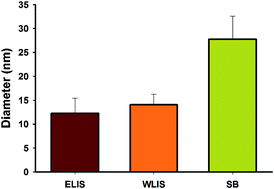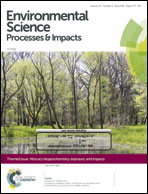The precipitation, growth and stability of mercury sulfide nanoparticles formed in the presence of marine dissolved organic matter†
Abstract
The methylation of mercury is known to depend on the chemical forms of mercury (Hg) present in the environment and the methylating bacterial activity. In sulfidic sediments, under conditions of supersaturation with respect to metacinnabar, recent research has shown that mercury precipitates as β-HgS(s) nanoparticles (β-HgS(s)nano). Few studies have examined the precipitation of β-HgS(s)nano in the presence of marine dissolved organic matter (DOM). In this work, we used dynamic light scattering (DLS) coupled with UV-Vis spectroscopy and transmission electron microscopy (TEM) to investigate the formation and fate of β-HgS(s)nano formed in association with marine DOM extracted from the east and west of Long Island Sound, and at the shelf break of the North Atlantic Ocean, as well as with low molecular weight thiols. We found that while the β-HgS(s)nano formed in the presence of oceanic DOM doubled in size after 5 weeks, those forming in solutions with coastal DOM did not grow over time. In addition, when the HgII : DOM ratio was varied, β-HgS(s)nano only rapidly aggregated at high ratios (>41 μmol HgII per mg C) where the concentration of thiol groups was determined to be substantially low relative to HgII. This suggests that functional groups other than thiols could be involved in the stabilization of β-HgS(s)nano. Furthermore, we showed that β-HgS(s)nano forming under anoxic conditions remained stable and could therefore persist in the environment sufficiently to impact the methylation potential. Exposure of β-HgS(s)nano to sunlit and oxic environments, however, caused rapid aggregation and sedimentation of the nanoparticles, suggesting that photo-induced changes or oxidation of organic matter adsorbed on the surface of β-HgS(s)nano affected their stability in surface waters.

- This article is part of the themed collection: Mercury Biogeochemistry, Exposure, and Impacts


 Please wait while we load your content...
Please wait while we load your content...